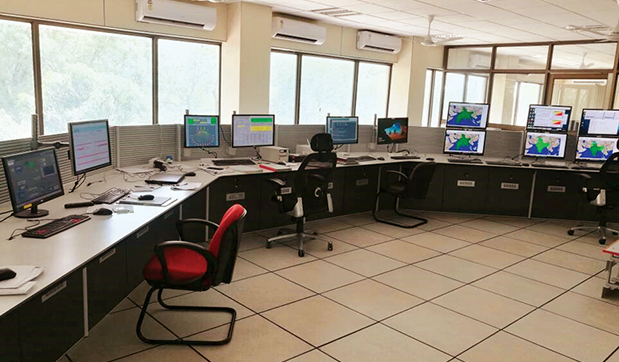GAGAN
AIBM
July - September 2017
To ensure that GAGAN runs smoothly and efficiently and to completely eliminate the possibility of interruption to the system due to possible disasters, new centres have been set up in an initiative that will help provide geographical redundancy.
Airports Authority of India (AAI) is continuously endeavouring to streamline and upgrade its systems and procedures for harmonisation of Indian airspace thus ensuring its commitment to providing fail-proof service. In this process several steps have been initiated by AAI. One such step is the implementation of GPS Aided GEO Augmented Navigation (GAGAN) over Indian airspace. In order to provide the geographical redundancy in the system, an additional master control centre has been added in the GAGAN configuration. It is located at GAGAN Complex, Nangloi, Delhi.
Mission Control Centres
The GAGAN Indian Mission Control Centre (INMCC) is the core facility of GAGAN, located at Bengaluru, where the data from all the Indian Reference Stations (INRES) is received for processing. The main function of INMCC is the generation of corrections and integrity messages for GAGAN. The important sub-systems of INMCC are Data Communication Sub-System (DCSS), Correction and Verification Sub-System (CVSS), Operations and Maintenance SubSystem (OMSS) and Service Monitoring Sub-System (SMSS).
At the core of INMCC is a safety computer that uses RTCA DO-178B Level B safety-certified software to calculate the integrity bounds for each GPS satellite in view of the system, as well as ionospheric corrections and integrity bounds for the ionospheric distortions that affect the GPS signal. Also part of the INMCC is a corrections processor for generating corrections for GPS clock and ephemeris errors. A GPS clock is used to synchronise GAGAN network time to GPS time. The other main component of the INMCC is a set of routers that receive data from the rest of the system, and allow the INMCC to communicate with other sub-systems.
Present GAGAN system ground infrastructure consists of 15 INRES, two INMCC and three Indian Land Uplink Stations (INLUS). Both the primary and backup INMCCs are currently located in the same building in Bengaluru. A potential disaster such as fire, natural disasters (e.g., earthquakes, floods, etc.), radiation, power outage, or explosions could cause both primary and backup INMCCs to shut down and thereby result in signal loss of continuity. In essence, collocation of INMCCs creates a single point of failure. To prevent this from occurring, another INMCC at Delhi has been built to provide sufficient geographical separation.
Master Control Centres
Along with that, an operational Satellite Based Augmentation System (SBAS) requires a minimum of two master control centres in order to ensure a basic level of redundancy to meet system continuity requirements. However, since SBAS is a dynamic system requiring regular software updates, for the testing of new software updates, three master control centre configuration is adopted in GAGAN system. The third master control centre has been integrated into the system as another hot standby for precautionary reasons, but this will also be useful when maintenance is required on any of the three master centres allowing two other to still be available for operational control and monitoring.
To ensure continued operations in the event of a natural disaster, and to reduce vulnerability to a severed communication trunk line, at least two of the master stations should be geographically separate. This configuration is adopted in line with other countries that have already developed SBAS for their region.
When a new software build is being tested, the third master centre could be physically and procedurally disconnected from the operational system and used as a shadow system, taking inputs from the operational system to test the performance and conformity of a new software build, but precluded from broadcasting a signal-inspace until safety certification is complete and the third master centre is reintegrated into the system. At this point, a sequential software upgrade could be made to the other two master centres.
Delhi INMCC has been built with the hardware and software identical to existing Bangalore INMCCs in order to save time and to effect seamless integration along with safe and uninterrupted operation of the certified GAGAN system. The performance of the new INMCC system has been tested and meets all the requirements defined by International Civil Aviation Organization (ICAO). Its installation and testing was an in-house initiative by the GAGAN team of AAI. Delhi INMCC system is currently put into Minimum Basic Shadow System mode to test the capability of GAGAN operational software in an isolated test environment utilising on line tools.











